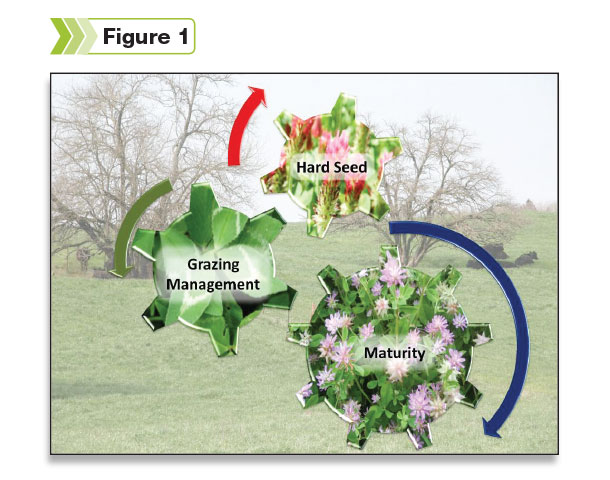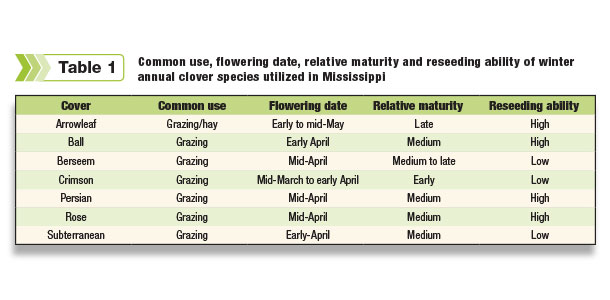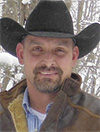Clovers also aid in extending the growing season, thus reducing the costs of winter supplementation. They are generally very digestible and contain high levels of crude protein, which lead to increased animal performance and profitability.
Growing clovers with pasture grasses greatly enhances cost-effectiveness in forage or livestock production but in some instances are considered undependable in their ability to reseed.
Annual clovers complete their life cycle each year. They are usually planted in the fall, and they cease production by late spring. Clovers can be re-established annually by either replanting or allowing plants to propagate, depending on reseeding ability.
The dependence on natural reseeding might not be the most practical approach because of the increased risk of establishment failure.
To establish adequate stands relying on natural reseeding depends on favorable environmental conditions along with grazing management practices in late spring to enhance clover seed production.

Most clovers that have reseeding potential will also produce a large percentage of “hard” seeds. A hard seed is a seed that does not swell or germinate within its established period of viability.
A hard seed has a tough impermeable coat that does not allow water or air to reach the embryo, which delays germination for long periods of time. Hard seed may survive passage through the digestive tracts of animals and can remain viable in soil for more than 15 years.
Delayed germination by hard seed of annual legumes grown in harsh environments helps maintain stands when conditions are not favorable for seed production in a particular year.
The quantity of hard seed depends on the conditions that existed during seed formation and maturation. For example, the amount of hard seed during drought conditions can increase by 40 to 60 percent.
For natural reseeding to occur, grazing and hay harvest should be managed to allow some of the clover to mature in late spring for seed production. Clover species that produce a high percentage of hard seed provide more dependable volunteer stands than those that produce more soft seed.
Self-reseeding annual cover crops can regenerate in subsequent years without tilling the seedbed and can be part of a strategy to protect the existing sod or to protect soil from erosion.

Let’s examine some of the characteristics that some of the most common annual clovers grown for forage might exhibit as potential reseeders. Table 1 also provides a summary of some of these characteristics.
- Arrowleaf clover is a late-maturing, tall, upright clover that produces most of its growth in late spring and can maintain productivity through late May.
Arrowleaf is a prolific seed producer, particularly of hard seed. Hard seed production ranges from 75 to 90 percent. The flowers bloom from bottom to top, and the flower head will continue to grow taller and produce more seed as long as growing conditions are optimal.
If arrowleaf has been grown in a pasture for several years, its ability to reseed dependably is seriously compromised by a Fusarium spp. disease complex. Some of the varieties available in the market include Yuchi, Apache Bolansa and Blackhawk.
- Ball clover is a low-growing clover that is tolerant of close grazing. Because it produces a high percentage of hard seed and much of its seed is produced close to the ground, it is an excellent reseeder.
Hard seed content is about 60 to 80 percent and will produce some flowers even under close grazing. Ball clover produces most of its growth about one month later in spring than crimson clover and generally produces slightly less total forage. Some of the varieties available include Grazer’s Select and AU Don.
- Berseem clover is an erect-growing legume with hollow stems and a short taproot. Berseem clover produces a large amount of seed but very little hard seed, so natural reseeding may be undependable.
Hard seed percentage is only about 10 percent. Most berseem clover lines are non-reseeding, but the cultivar “Bigbee” has been reported to produce adequate hard seed for reseeding stands. Some of the varieties available include Bigbee, CW902 and GO-Ber-10.
- Crimson clover is the earliest maturing annual clover. Range in maturity of present varieties is about 12 days. Flowers open from the bottom of the flower head to the top.
If the weather is hot and sunny, all the blooms open at once. Then not every flower gets pollinated, and the seed yield is lower. It produces relatively little hard seed and its seed heads are often damaged by clover-head weevils.
As a result, crimson clover usually does not reseed well in a grazing system. Hard seed percentage averaged about 35 percent after seed maturation but decreased to 10 percent 90 days later. Most soft seed germinates with the first rain after seed maturation. Some of the varieties available include Dixie, Tibbee, AU Robin and AU Sunup and Bolsena.
- Persian clover is distinctive because of its toothed margins and pink flowers that produce olive green to purple seeds. Despite being a relatively low-yielding cool-season annual legume with a short growing season, Persian clover performs well under close grazing.
Some of the varieties available include Abon, Prolific, Nitro, Kyambro, Lightning, Morbulk, Laser and Maral.
- Rose clover has two very distinctive characteristics: very hairy stems and pale green stipules. It generally stands up well under heavy grazing, but animals should be removed in mid-April to allow the stand to produce seed.
Rose clover is an excellent reseeder because of a hard seed percentage of 90 percent. Some of the varieties available include Hykon, Kondinin, Wilton and Overton R18.
- Subterranean clover is a low-growing clover (less than 1.5 feet tall) but will create a very dense forage mat. Due to its growth habit, subterranean can tolerate frequent close grazing and shading by grasses better than other clovers.
It has excellent reseeding potential because it buries its seed pods underground. Hard seed percentage can be low because of rainfall during seed maturation that results in unreliable reseeding.
Reseeding appears to be better on heavy soils than lighter soils. Some of the varieties available include Bacchus Marsh, Clare, Daliak, Larisa, Northam, Nungarin, Seaton Park, Trikkala, Woogenellup, Mt Barker, Carridale, Denmark, Clare and Nuba.
Grazing management for reseeding
Grazing until early April often results in more seed production compared to not grazing at all. This is due to heavy, dense growth resulting in lodged plants, matted forage and reduced numbers of blooms.
To allow adequate reseeding, remove livestock from the paddocks or reduce stocking rates in late April or early May when the clover starts to flower or bloom. During the four-week to seven-week flowering period, seeds mature in the bottoms of seed heads first, and some mature seed should be present by late May.
Keep in mind that when growing clover mixtures in the same pasture, flower production might vary due to maturity rate of the species. It might be necessary to keep animals off the pasture for a longer period of time. Differences in seed and flower production among species can range from 20 to 40 percent.
Once the seed heads have matured, livestock could be returned to grazing those areas. Some clovers with low growth stature can tolerate close continued grazing and still have optimum seed production, resulting in a greater opportunity to reseed in pastures than clover species with more upright growth.
Successful establishment of annual legumes is achieved only with the use of varieties that have both high persistence and high productivity within the specific environment in which they are introduced.
Self-reseeding annual legumes can play an increasingly important role in winter forage production because the cost of annual planting would be eliminated. Annual legumes are flexible components within livestock enterprises to increase economic and environmental sustainability. FG
–Excerpts from Mississippi State University newsletter Forage News, Volume 6, Issue 1, January 2013









